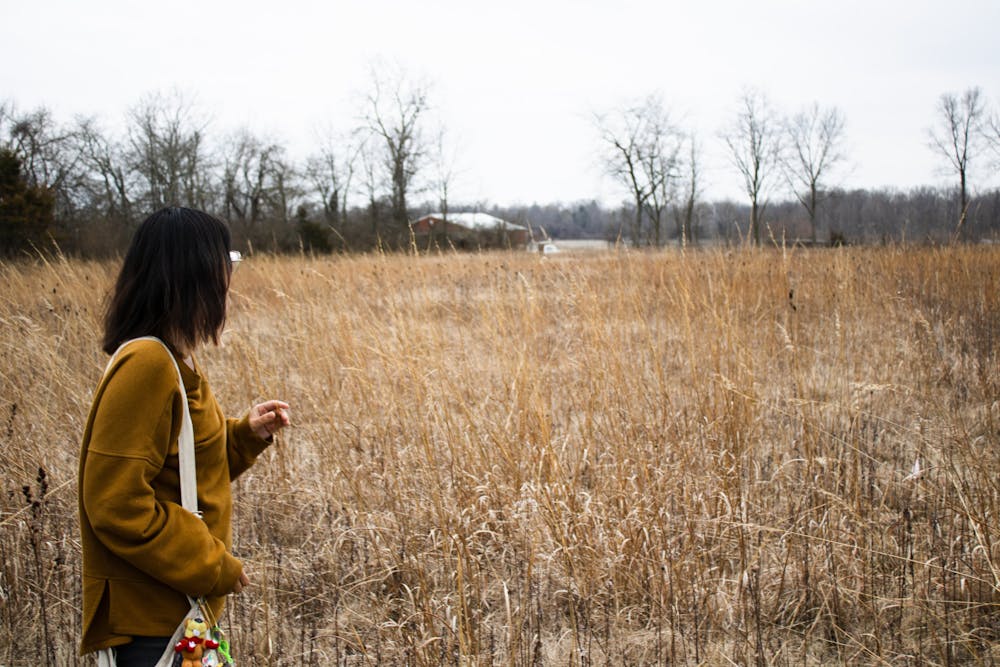A lone bald eagle soars out of trees against a deep gray sky, high above a restored prairie full of legumes and big bluestem. A vintage but functional weather station creaks nearby, and in the distance, a red barn sits on the edge of a large grassy field dotted with vegetation plots.
Miami’s Ecology Research Center (ERC) is alive with natural systems and scientific wonder.
Located five minutes north of campus along Somerville Road, this 170-acre field station was founded in 1969 to research the natural world. The diverse parcel of land includes agricultural fields, prairies, old and new-growth forests, and dozens of acres of grassy fields that have been manipulated to allow for extensive field research.
The ERC does not stick to one area of research but rather allows students and professors the opportunity to conduct many different types of studies. Dozens of water tanks dot the western side of the field station, while hundreds of individual research plots ranging from low-growing herbs and legumes to closed habitats housing prairie voles are scattered around the central field.
“We have so many different things going on that we can offer,” said Jeremy Fruth, who has been the manager of the ERC for the last 10 years. “You know, we're going to go grab some tadpoles out of a pool today, or we're going to collect some insects that we're going to do some further research back in the lab on or we're going to go explore some honey bees.”
Everything from agricultural research to weather monitoring can be found among the woods and prairies, and Fruth believes the ERC’s large size and diverse landscape contribute to the diversity of activity. Each year, the ERC houses research projects for more than 30 graduate students, while many more undergraduate students get to experience field research as assistants or as part of the many classes that utilize the space, such as BIO 433 Field Ecology.
The ERC is set up to allow researchers to conduct replicate studies, slightly changing variables of the experiment while allowing natural processes to interact. Students using the ERC appreciate how the close location and natural setting allow for greater complexity and variability in their experiments.
Isabelle Turner, a second-year master's student in biology, uses both the Belk Greenhouse on Western Campus and the ERC to conduct her research on prairie diversity and microbial mutualists.
“It's really nice to have the greenhouse component where it's not as contaminated, and then in the field, you can see how environment influences, and insects and pretty much everything else,” Turner said.
Along with its size, the ERC is close to Miami's main campus for a field station. This accessibility makes it easier for hundreds of students to interact with it every year.
“It's not uncommon for universities to have field stations or things like that,” said Jonathan Bauer, an assistant professor of biology and director of the ERC. “But it's pretty uncommon to have it just right here to where you can bring students out in the middle of the workweek and get stuff done.”
Enjoy what you're reading?
Signup for our newsletter
Those who work at the ERC see that the plentiful use of the area has created a warm and collaborative community. Along with sharing tools, equipment and spaces, those working at the ERC learn from each other. The natural outdoor classroom and lab doesn’t have walls sectioning off the different experiments and disciplines, so students interact with each other often.
“A lot of labs get tied down to like, being in their lab,” said Emily Galloway, a Ph.D. candidate in the department of biology studying prairie diversity and restoration. “So it's really special to be able to interact with them face to face or to see them later in the day, like, ‘Hey, I saw you at the ERC. What were you doing?’”
Along with student research, the ERC hosts and collaborates with many other organizations, both local and national. Audubon Miami Valley uses it for its Christmas bird count, and in 2022, the National Envirothon, a conservation and leadership competition for high school students, was held at the ERC.
Undergraduate students have plenty of opportunities to use the ERC outside of classes to enhance their college experience. Fruth explained that in the past he had to hire technicians to keep the ERC running, but nowadays undergraduate students fill that role. Nearly all of the graduate students have an undergrad helping them with their research.
Field research at the ERC can be time-consuming. In the summer, students may spend nearly every day in the field, and the semester still requires lots of time spent on their research. But this commitment to uncovering the mysteries of the natural world has formed a tight community, and those who use the ERC cherish the scientific and personal growth that comes with it.
“I don't know if it's because they're in my cohort or if it's because we do research here,” Galloway said, “but the people I'm closest with do research at the ERC.”




